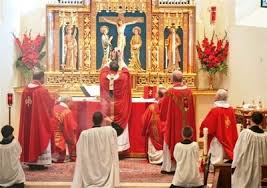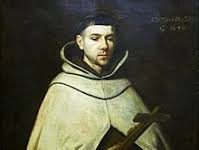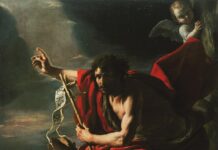This Sunday’s reflection is the third in a series of meditations on the Holy Sacrifice of the Mass, with specific references to the Ancient Rite of the Mass. There are many books in circulation that illustrate the theological and spiritual cohesion of the Ancient Rite of the Mass. It is the Rite that sustained and nourished the spiritual life of countless saints and which gave birth to Christian culture. It is my hope that these meditations may help us to appreciate and to understand that the ultimate purpose of the sacred liturgy is to form our souls in the beauty of holiness; so that we in our time, like those who have gone before us may be ‘the aroma of Christ to God…a fragrance from life to life’ (2 Cor. 2:15-16) for God’s greater glory and the salvation of souls.
⧾
Then Jesus took the loaves, and when he had given thanks, he distributed them to those who were seated; so also the fish, as much as they wanted (Jn. 6:8).
Today we begin to read from the sixth chapter of St. John’s Gospel, Our Lord’s Eucharistic discourse, and we continue our meditations on the Holy Sacrifice of the Mass, our central act of worship, the source and summit of Christian life (Sacrosanctum Concilium, 10; Constitution on the Sacred Liturgy, Vatican Council II); the very heart of all that the Church is and does. We have already considered the importance of the Introductory Rites of the Mass, namely the Penitential Rite, as a worthy preparation for an attentive listening to the Word of God; and the importance also of the homily or sermon as an integral part of our worship and the principal means of our ongoing instruction and formation in the faith. The recitation of the Creed marks the end of the part of the Mass which in the Extraordinary Form is called the Mass of the Catechumens. What follows the Creed in the Ordinary Form of the Roman Rite is the Prayer of the Faithful. Although strictly speaking this is part of the what is generally referred to as the Liturgy of the Word, this Universal Prayer is rightly seen as an exercise of the priesthood of the faithful which is ours through Baptism and for this reason it serves as point of transition to the Liturgy of the Eucharist or what in the Tridentine Rite is called the Mass of the Faithful.
The Epistle to the Hebrews is a sacred text which outlines the continuity between the Old and the New Covenants in the worship given to God. It says of Our Lord that in the days of his flesh, Jesus offered up prayers and supplications, with loud cries and tears…[and that he] was designated by God a high priest after the order of Melchizedek (5:7-10). In the Prayer of the Faithful or Universal Prayer we likewise offer up prayers and supplications not only for our own particular needs but also for the world and the salvation of mankind; mindful that the salvation of the many depends on the prayers and the voluntary penances which the members of the Mystical Body of Jesus Christ offer for this intention (Pope Pius XII, Mystici Corporis, 29 June 1943). The scope of our prayer embraces the whole world, for we join our prayers and sacrifices to the prayer of Christ the Eternal High Priest. The Seven Offerings of the Precious Blood which we pray especially though not exclusively during this month of July is a daily universal prayer of sorts. This exercise of the priesthood of the faithful prepares us for the Offertory of the Mass, the first part of the Mass of the Faithful.
It is at this point in the Mass that the bread and wine which will become Our Lord’s Body and Blood are brought to the Altar. The collection which is customarily taken up on Sundays is the sacrificial expression of both our prayer as well as an expression of our gratitude for blessings received. These offerings which enable us to sanctify our work are the source of untold good for those whom the Church serves. It is an undeniable fact that the Catholic Church is the most generous servant of humanity and our service goes beyond providing food and shelter and alleviating material poverty. Our churches throughout the world are more than functional places where we gather to worship. From the greatest and most ornate cathedrals to the most humble of parish churches, these sacred edifices are meant to reflect the holiness of beauty and the beauty of holiness. Here our spiritual poverty is remedied and this too is a service to humanity. Those who are tempted to dismiss and reproach what some mistakenly characterise as extravagance in the beauty of sacred worship, forget that man does not live by bread alone and that the worship we give to God should be noble and beautiful. Rich and poor alike share in this beauty of holiness.
The Offertory Prayers of the Traditional Rite of the Mass express very clearly the sacrificial nature of the Mass and the intercessory role of the Priest at the Altar. When prefect of the Congregation for Divine Worship, Robert Cardinal Sarah encouraged priests to use these traditional prayers in the celebration of the Mass of Paul VI. Before the wine is offered, the priest pours a bit of water in the wine. The wine represents Our Lord’s divine nature, while the drop of water that is mixed with it represents His human nature – and with it ourselves. Just as the two are mingled in the chalice and can no longer be separated, by joining our sacrifice to the one being offered on the Altar, we hope to become one with Christ through the Eucharist. In solemn Masses the offerings of bread and wine are incensed along with the Altar and all those present. Just as Mary Magdalene anointed Our Lord’s feet with costly ointment, we cloud in fragrance our offering and all those participating in it. Incense is an aromatic resin. In the ancient world it was a very costly sacrifice and in the Temple in Jerusalem it was burned twice daily on a special altar. On the Day of Atonement coals from this altar as well as incense were taken into the Holy of Holies where it was burned in solemn ceremony. In the Book of Revelation where we are given a vision of the Heavenly Liturgy we read: And another angel came, and stood before the altar with a golden censer; and he was given much incense to mingle with the prayers of all the saints upon the golden altar before the throne; and the smoke of the incense rose with the prayers of the saints from the hand of the angel before God (8:3-4).
As the priest incenses the Altar in a High or Solemn Mass, he prays these words from Psalm 140: Let my prayer be counted as incense before thee, and the lifting up of my hands as an evening sacrifice. The Offertory ends with an invitation to prayer expressing what is about to take place: Pray, brethren, that my sacrifice and yours may be acceptable to God the almighty Father. The prayer rightly distinguishes the two sacrifices about to be offered. The priest is about to re-present Christ’s Sacrifice on the Altar. This is why we rightly say that the Mass is Calvary. In the Mass Our Lord offers the perfect Sacrifice for us and we join our own sacrifices with His; uniting ourselves with the Host upon the Altar – our prayers, offerings and sacrifices are thereby imbued with a power and efficacy that enables us to say, I have been crucified with Christ; it is no longer I who live but Christ who lives in me; and the life I now live in the flesh I live by faith in the Son of God, who loved me and gave Himself for me (Gal. 2:20). This is how conscious, active and fruitful participation at Mass is best understood and for this reason, it is the most effective manner of assisting at Holy Mass, of praying the Mass, and of living the Mass (lex orandi, lex credenda, lex vivendi).
The Church teaches us that in the earthly liturgy we take part in a foretaste of that heavenly liturgy which is celebrated in the holy city of Jerusalem toward which we journey as pilgrims, where Christ is sitting at the right hand of God, a minister of the holies and of the true tabernacle (Sacrosanctum Concilium, 8). The outright denial of the sacrificial nature of the Mass or ignorance of this truth is at the heart of the crisis the Church is experiencing today; and by extension, the crisis in the world. The Traditional Mass ensures that genuinely truthful religious instincts may be once again recovered and fostered, and this may explain why so many young people and young families seeking out the Traditional Mass; some traveling great distances for such a celebration of Holy Mass. Unless we recover the sense of the sacred, and so accept the truth of Divine Revelation, we risk being overwhelmed by the progressivist and Modernist invasion that has emptied our churches and laid waste to our once vibrant religious communities. The remedy is in the Mass itself, as increasingly many are discovering.
It has been observed that you cannot have a culture without cult – that is, without shared belief in and submission to a sacred order (R. Dreher, Live Not by Lies, p. 12). Again, the structure and nature of the Traditional Mass both unequivocally present such a sacred order and invite a transformative submission to the dynamic of grace. This is by far more appealing not only because of its inherent truth, but also because of its coherence to our own human nature, than what has generally taken hold in the West. It is described as Moralistic Therapeutic Deism – a decadent form that Christianity (and all faiths in fact) (Ibid. p.12). This consists of the general belief that God exists, and wants nothing more from us than to be nice and to be happy (Ibid. p.12). Simply stated, we were created in the image and likeness of God who is self-giving, self-communicating, self-sacrificing Love. To the extent that our lives reflect God’s essential nature, we are fulfilled and therefore, truly happy. The Mass is the school of faith and the feast of faith, and as such, the school of life itself, authentic life; well-ordered and focused on the ultimate goal of human existence – a participation in the very life of God in the Beatific Vision. The ephemeral pleasures, passions and honours of this world, legitimate as they may be, can never bring us complete fulfillment. Christian history, at least as it concerns its most important aspect; that is the chronicle of those who have understood and striven to be ‘partakers of the divine nature’, is the record of those who have most benefited humanity living lives of meaningful purpose. All that we need to know about life and how to live it is communicate to us in the Holy Sacrifice of the Mass – perhaps most efficiently in the Offertory of the Mass. May every Mass we attend deepen our ability to recognise that these most sacred mysteries are the means to sanctify our present way of life and [to] lead us to eternal happiness (Prayer Over the Offerings, Seventeenth Sunday Per Annum, The Roman Missal).











